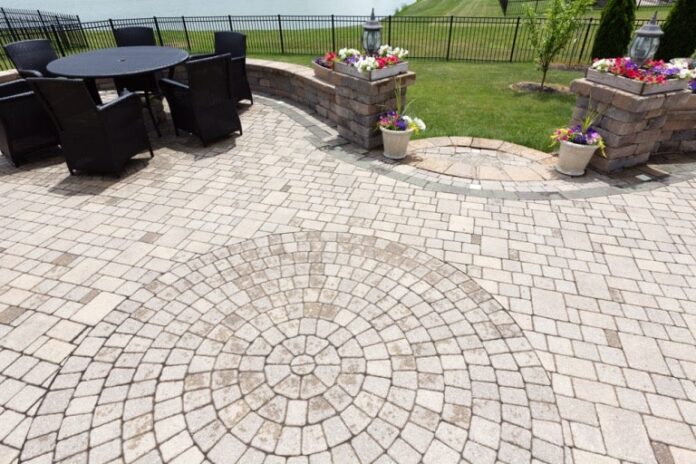Keeping your outdoor pavers looking fresh and new can significantly enhance your property’s curb appeal and value. Whether you’ve chosen brick, concrete, stone, or even porcelain pavers, proper maintenance is key to prolonging their life and beauty. In this guide, we’ll explore effective tips and strategies to maintain your pavers, ensuring they remain in top condition year after year.
Understanding the basics of paver maintenance
Paver maintenance doesn’t have to be complicated. A regular routine can help you avoid major repairs and keep your pavers looking new. The longevity of your pavers depends on how well you tackle the cleaning, sealing, and general upkeep.
Implementing seasonal maintenance
Adjusting your maintenance routine to accommodate seasonal variations is key to preserving the quality and appearance of your pavers year-round. Each season presents unique challenges and opportunities for care:
● Spring: Post-winter recovery
Spring cleaning is crucial. Remove salt residues and debris accumulated during winter, check for damage from freeze-thaw cycles, and perform necessary repairs. Replenish joint sand if it has been washed out or displaced.
● Summer: Preventing sun damage
Protect pavers from fading due to UV rays by ensuring your sealant is up to date, which should include UV protection. Summer’s heat also promotes weed growth; maintain regular weeding and consider a pre-emergent herbicide to prevent weeds from rooting in the joints.
● Fall: Preparing for cold weather
Prepare your pavers for winter by performing a thorough cleaning and a fresh application of sealant to guard against water and ice damage. Remove all leaves and organic materials to prevent potential stains and the growth of mold and mildew.
● Winter: Minimizing damage
During winter, opt for calcium chloride over rock salt for de-icing to minimize paver corrosion. Keep pathways clear of snow and ice to reduce moisture infiltration and prevent safety hazards.
Season-specific maintenance not only keeps your pavers in optimal condition but also extends their durability and enhances their aesthetic appeal throughout the year.
Regular cleaning
The first step in paver maintenance is routine cleaning. Removing dirt and debris prevents the buildup of stains and helps maintain the original color of the pavers. For regular cleaning, a simple solution of mild detergent, water, and a stiff brush can do wonders.
Scrubbing your pavers every few months will keep them looking vibrant and prevent moss and weed growth. Additionally, using a pressure washer on a low setting can effectively remove more stubborn dirt without damaging the pavers.
Stain prevention and removal
Stains can detract from the beauty of your pavers, but quick action can prevent permanent damage. Oil, grease, and leaves are common culprits for staining. To combat these, consider applying a commercial-grade paver sealer that provides a protective barrier against stains.
If stains do occur, it’s important to address them promptly. Specific cleaning solutions designed for paver stains are available and should be used according to the manufacturer’s instructions.
Managing weed growth
Weeds not only look unsightly but can also cause structural damage to paver installations as they grow through the joints. Ensure that your pavers are properly installed with a good base and edge restraint to prevent weeds. Regularly sweeping and topping up joint sand can also help deter weed growth.
Use a spot treatment with an appropriate herbicide or a natural solution like vinegar for an eco-friendly option for existing weeds.
Sealing your pavers
Sealing is a critical step in maintaining the longevity and appearance of your pavers. A quality sealant helps protect against weathering, fading, and staining. It also enhances the color of your pavers, giving them a fresh, wet look.
Sealers should be applied every two to three years, depending on the type of pavers and the level of exposure to traffic and weather conditions. Always ensure the pavers are clean and dry before applying sealant for the best results.
Handling freeze-thaw cycles
In colder climates, the freeze-thaw cycle can significantly threaten pavers. Water that seeps into the pores and joints can freeze, expand, and eventually crack the stones.
To protect your pavers, ensure they have proper drainage to prevent water accumulation. Using a sealer can minimize the amount of water that penetrates the surface.
Repair and replacement
Despite best efforts, pavers may become damaged or uneven over time. Regularly inspect your paver installation for any signs of settling or shifting, particularly after heavy rains or freeze-thaw cycles.
Early detection and repair of these issues can prevent more extensive damage. For pavers that are cracked or severely stained, replacement might be the only option. Always keep extra pavers from the original batch to ensure a perfect match for repairs.
Special consideration for porcelain pavers
Porcelain pavers are a popular choice for their durability and low maintenance needs. However, they still require care to keep them looking their best. Avoid using abrasive tools or high-pressure washers that could damage the surface.
For cleaning, a gentle detergent and soft brush are usually sufficient to maintain their appearance without the risk of scratching or pitting.
Conclusion
Maintaining your pavers is a straightforward yet crucial part of home maintenance that extends the life and beauty of your outdoor spaces. By following these tips—regular cleaning, stain management, weed control, sealing, and monitoring for repairs—you can enjoy pristine and durable walkways, patios, and driveways for many years.
Start implementing these practices today, and see the difference in the longevity and aesthetics of your paver installations. Remember, a little effort goes a long way in keeping your pavers looking new!
